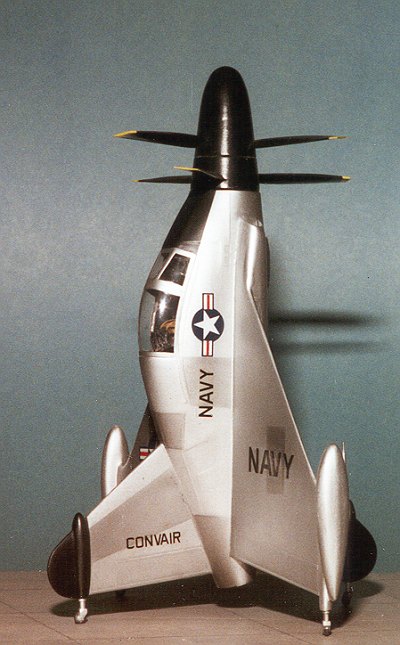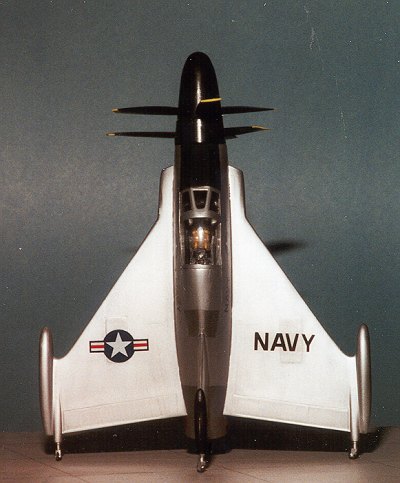 Lindberg 1/48 XFY-1 'Pogo'
Lindberg 1/48 XFY-1 'Pogo'
 Lindberg 1/48 XFY-1 'Pogo'
Lindberg 1/48 XFY-1 'Pogo'
Kit Number: 536
Price: $6.75
Decals : One version, the prototype
Date of Review: 30 Nov, 1996
Comments: Back in the mid-1950s, there was a serious attempt by the US Navy to develop an aircraft that could take off and land vertically. This would eliminated the need for many large aircraft carriers and provide instantly availability of air support for landing troops. At this time, it was thought that the best way to provide this was with a tailsitting aircraft, and since supersonic speed was not necessary, the newly developed turboprop was to be used. Two companies, Lockheed and Convair were chosen to provide prototypes. Both airframes used an experimental turboprop engine and both were designed to be tail sitters. There the similarity ends. The Lockheed entry, the XFV-1 used F-104-like wings and an X shaped tail, whereas the Convair entry, the XFY-1 used a delta planform and + shaped tail. Only the XFY-1 was able to successfully take off and land vertically. Both were not successful for several reasons. One being the lack of power and reliability from current turboprops, the other being the very high amount of pilot skill required to successfully land a tail-sitting aircraft. As you probably know, these areas were overcome by the development of the Harrier, but that is another story.
This kit by Lindberg is by no means new, initially being produced about the same time as the XFY-1 was being tested. It is a very simple kit, but accurate in outline. It is produced in light grey plastic with the required rivets and a very nice working counter-rotating propeller. Now on to the building. This kit has absolutely no interior, providing only a head on a blanking plate. The first thing I did was to scratch build an interior. I used some photos from a Wings magazine and spent probably 60% of the building time making a near replica of the XFY-1s interior.
 I used plastic card to make a tub and side consoles. Then the instrument
panel was shaped using the photographs and holes drilled into it. A
backing plate was made and when dry the instrument areas painted white.
Reheat instrument decals were placed in the holes and they look very
much like real instrument faces. Next the back parts of the instruments
were simulated with various sizes of Contrail rod and wire lead off the rear
of the instruments into the airframe. Finally, supports for the panel were
made using Contrail rod and the whole assembly cemented into place. The
control stick was made of bent rod and spare consol decals used on the side consoles. I think it turned out very well.
I used plastic card to make a tub and side consoles. Then the instrument
panel was shaped using the photographs and holes drilled into it. A
backing plate was made and when dry the instrument areas painted white.
Reheat instrument decals were placed in the holes and they look very
much like real instrument faces. Next the back parts of the instruments
were simulated with various sizes of Contrail rod and wire lead off the rear
of the instruments into the airframe. Finally, supports for the panel were
made using Contrail rod and the whole assembly cemented into place. The
control stick was made of bent rod and spare consol decals used on the side consoles. I think it turned out very well.
The only thing I could not properly duplicate was the experimental ejection seat so used a similar white metal seat from Aeroclub to fill the bill. It is quite convincing and looks great under the XFY-1's crystal clear canopy. Other modifications included building an exhaust and building intake and cooling ducts for the engine and oil cooler. These were built more to prevent a see-through look than anything else.
The rest of the kit was sanded free of rivets and painted in several shades of Metallizer. The contra-rotating propeller assembly can be fitted without cementing and this helps to keep the props from being broken during many moves. The decals in the kit were out of register and of poor quality so the spares box was raided for insignia and Navy lettering. The serial number came from Scalemaster sheets as did the Convair logos. Overall a very satisfying kit and one that has been on my display shelves since 1988.
Copyright ModelingMadness.com. All rights reserved. No reproduction in part or in whole without express permission from the editor.